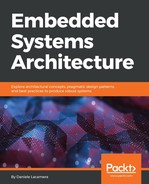A different approach is SPI. Introduced in the late 1980s, this technology aimed to replace asynchronous serial communication towards peripherals, by introducing a number of improvements:
- Serial clock line to synchronize the endpoints
- Master-slave protocol
- One-to-many communication over the same three-wire bus
The master device, usually the microcontroller, shares the bus with one or more slaves. To trigger the communication, a separate slave select (SS) signal is used to address each slave connected to the bus. The bus uses two independent signals for data transfer, one per direction, and a shared clock line that synchronizes the two ends of the communication. Due to the clock line being generated by the master, the data transfer is more reliable, making it possible to achieve higher bitrates than ordinary UART. One of the keys for the continued success of SPI over multiple generations of microcontrollers is the low complexity required for the design of slaves, which can be as simple as a single shift register. SPI is commonly used in sensor devices, LCD displays, flash memory controllers, and network interfaces.
